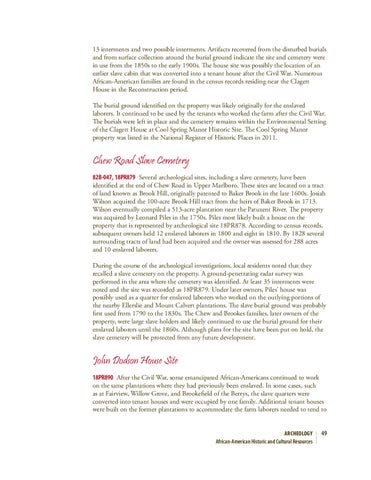13Â interments and two possible interments. Artifacts recovered from the disturbed burials and from surface collection around the burial ground indicate the site and cemetery were in use from the 1850s to the early 1900s. The house site was possibly the location of an earlier slave cabin that was converted into a tenant house after the Civil War. Numerous African-American families are found in the census records residing near the Clagett House in the Reconstruction period. The burial ground identified on the property was likely originally for the enslaved laborers. It continued to be used by the tenants who worked the farm after the Civil War. The burials were left in place and the cemetery remains within the Environmental Setting of the Clagett House at Cool Spring Manor Historic Site. The Cool Spring Manor property was listed in the National Register of Historic Places in 2011.
Chew Road Slave Cemetery 82B-047, 18PR879 Several archeological sites, including a slave cemetery, have been identified at the end of Chew Road in Upper Marlboro. These sites are located on a tract of land known as Brook Hill, originally patented to Baker Brook in the late 1600s. Josiah Wilson acquired the 100-acre Brook Hill tract from the heirs of Baker Brook in 1713. Wilson eventually compiled a 513-acre plantation near the Patuxent River. The property was acquired by Leonard Piles in the 1750s. Piles most likely built a house on the property that is represented by archeological site 18PR878. According to census records, subsequent owners held 12 enslaved laborers in 1800 and eight in 1810. By 1828 several surrounding tracts of land had been acquired and the owner was assessed for 288 acres and 10 enslaved laborers. During the course of the archeological investigations, local residents noted that they recalled a slave cemetery on the property. A ground-penetrating radar survey was performed in the area where the cemetery was identified. At least 35 interments were noted and the site was recorded as 18PR879. Under later owners, Piles’ house was possibly used as a quarter for enslaved laborers who worked on the outlying portions of the nearby Ellerslie and Mount Calvert plantations. The slave burial ground was probably first used from 1790 to the 1830s. The Chew and Brookes families, later owners of the property, were large slave holders and likely continued to use the burial ground for their enslaved laborers until the 1860s. Although plans for the site have been put on hold, the slave cemetery will be protected from any future development.
John Dodson House Site 18PR890 After the Civil War, some emancipated African-Americans continued to work on the same plantations where they had previously been enslaved. In some cases, such as at Fairview, Willow Grove, and Brookefield of the Berrys, the slave quarters were converted into tenant houses and were occupied by one family. Additional tenant houses were built on the former plantations to accommodate the farm laborers needed to tend to
ARCHEOLOGY African-American Historic and Cultural Resources
49
